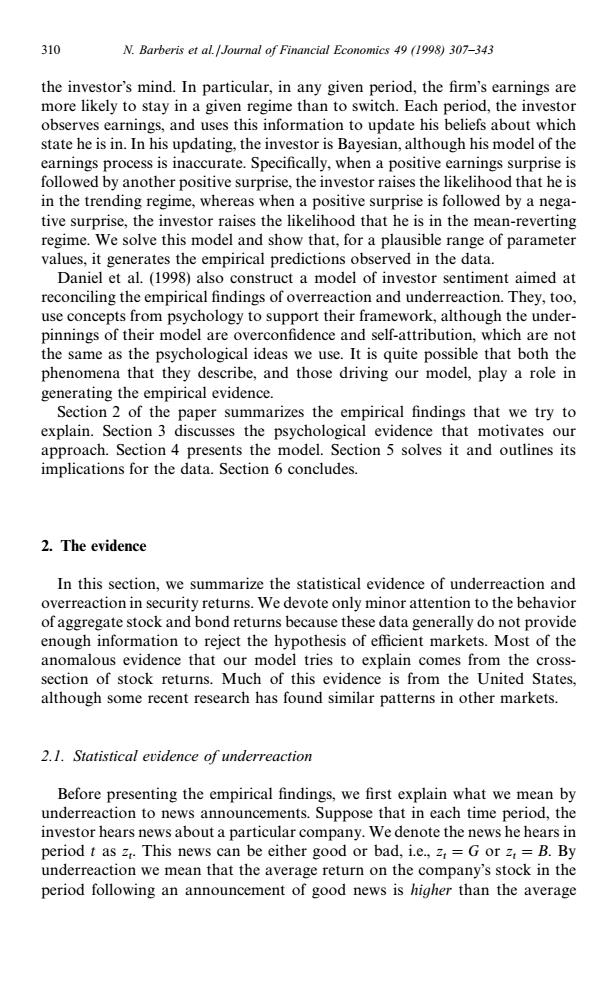正在加载图片...

310 N.Barberis et al./Journal of Financial Economics 49 (1998)307-343 the investor's mind.In particular,in any given period,the firm's earnings are more likely to stay in a given regime than to switch.Each period,the investor observes earnings,and uses this information to update his beliefs about which state he is in.In his updating,the investor is Bayesian,although his model of the earnings process is inaccurate.Specifically,when a positive earnings surprise is followed by another positive surprise,the investor raises the likelihood that he is in the trending regime,whereas when a positive surprise is followed by a nega- tive surprise,the investor raises the likelihood that he is in the mean-reverting regime.We solve this model and show that,for a plausible range of parameter values,it generates the empirical predictions observed in the data. Daniel et al.(1998)also construct a model of investor sentiment aimed at reconciling the empirical findings of overreaction and underreaction.They,too, use concepts from psychology to support their framework,although the under- pinnings of their model are overconfidence and self-attribution,which are not the same as the psychological ideas we use.It is quite possible that both the phenomena that they describe,and those driving our model,play a role in generating the empirical evidence. Section 2 of the paper summarizes the empirical findings that we try to explain.Section 3 discusses the psychological evidence that motivates our approach.Section 4 presents the model.Section 5 solves it and outlines its implications for the data.Section 6 concludes. 2.The evidence In this section,we summarize the statistical evidence of underreaction and overreaction in security returns.We devote only minor attention to the behavior of aggregate stock and bond returns because these data generally do not provide enough information to reject the hypothesis of efficient markets.Most of the anomalous evidence that our model tries to explain comes from the cross- section of stock returns.Much of this evidence is from the United States, although some recent research has found similar patterns in other markets. 2.1.Statistical evidence of underreaction Before presenting the empirical findings,we first explain what we mean by underreaction to news announcements.Suppose that in each time period,the investor hears news about a particular company.We denote the news he hears in period t as z This news can be either good or bad,i.e,z=G or z=B.By underreaction we mean that the average return on the company's stock in the period following an announcement of good news is higher than the averagethe investor’s mind. In particular, in any given period, the firm’s earnings are more likely to stay in a given regime than to switch. Each period, the investor observes earnings, and uses this information to update his beliefs about which state he is in. In his updating, the investor is Bayesian, although his model of the earnings process is inaccurate. Specifically, when a positive earnings surprise is followed by another positive surprise, the investor raises the likelihood that he is in the trending regime, whereas when a positive surprise is followed by a negative surprise, the investor raises the likelihood that he is in the mean-reverting regime. We solve this model and show that, for a plausible range of parameter values, it generates the empirical predictions observed in the data. Daniel et al. (1998) also construct a model of investor sentiment aimed at reconciling the empirical findings of overreaction and underreaction. They, too, use concepts from psychology to support their framework, although the underpinnings of their model are overconfidence and self-attribution, which are not the same as the psychological ideas we use. It is quite possible that both the phenomena that they describe, and those driving our model, play a role in generating the empirical evidence. Section 2 of the paper summarizes the empirical findings that we try to explain. Section 3 discusses the psychological evidence that motivates our approach. Section 4 presents the model. Section 5 solves it and outlines its implications for the data. Section 6 concludes. 2. The evidence In this section, we summarize the statistical evidence of underreaction and overreaction in security returns. We devote only minor attention to the behavior of aggregate stock and bond returns because these data generally do not provide enough information to reject the hypothesis of efficient markets. Most of the anomalous evidence that our model tries to explain comes from the crosssection of stock returns. Much of this evidence is from the United States, although some recent research has found similar patterns in other markets. 2.1. Statistical evidence of underreaction Before presenting the empirical findings, we first explain what we mean by underreaction to news announcements. Suppose that in each time period, the investor hears news about a particular company. We denote the news he hears in period t as z t . This news can be either good or bad, i.e., z t "G or z t "B. By underreaction we mean that the average return on the company’s stock in the period following an announcement of good news is higher than the average 310 N. Barberis et al./Journal of Financial Economics 49 (1998) 307—343